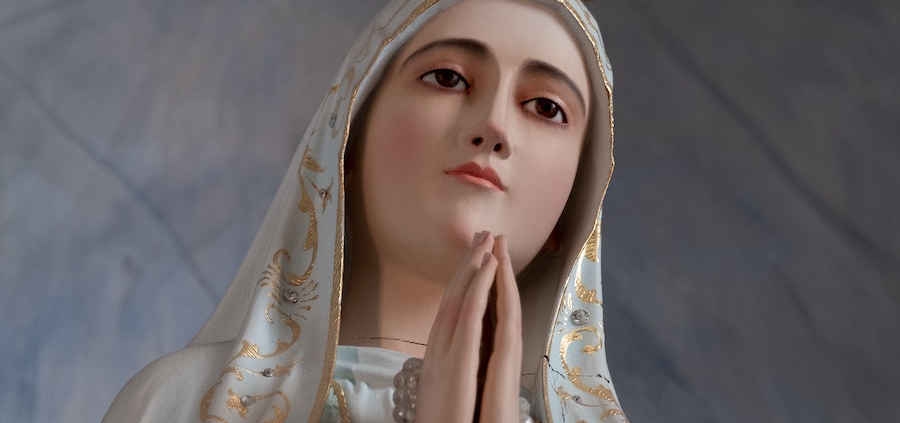Messenger of Peace by Chris Byrd
Fatima
Directed by Marco Pontecorvo
Picturehouse
PG-13 1 hour, 53 minutes
Italian director Marco Pontecorvo’s Fatima is a flawed yet ultimately life- and faith-affirming film. It recalls the dramatic historical events of the Virgin Mary’s appearance to a young girl outside the Portuguese village of Fatima during World War I.
The film opens with the encounter of the young girl, Lucia (played by Stephanie Gil), with an “angel of peace” in 1915. The angel shows Lucia images of her beloved older brother Manuel fighting in the Great War. To save him and young men like him, the angel urges the dazzled girl to pray for peace.
The film’s narrative is framed as an interview between Professor Nichols (Harvey Keitel) and an 82-year-old Lucia (Sonia Braga), a Discalced Carmelite at Saint Teresa Convent in Coimbra, Portugal, in 1989. The story is told through the elder Lucia’s memories as she responds to the professor’s questions.
Lucia explains that she was 10 years old when Our Lady of the Rosary appeared to her and younger cousins Francisco and Jacinta in 1917. Lucia believes she was chosen to play her part in these preternatural events because “it was necessary to spread [Our Lady’s] message.”
After the Virgin Mary first appears to the children, Lucia tells her mother, Maria (authoritatively played by Lúcia Moniz), “She was so beautiful and as real as you are.” The Virgin urges the children to pray the rosary for peace and instructs them to return to the same spot on the 13th of each month for the next six months, when more will be revealed to them.
Maria’s all-consuming fear she’ll lose Manuel in the Great War darkens her conviction that the children are making things up. Her life has been upended enough, and defending this fantastic tale asks too much of her, even as an observant Catholic. She takes Lúcia to their parish priest, Father Ferreira, to correct her. The pastor refuses to accept that the Mother of God would visit this girl and tells her that her embrace of the apparition is the devil’s work.
But it is the town’s mayor, Arturo, who most fiercely doubts the veracity of the children’s story. As the Virgin Mary continues to reveal herself through them, Arturo closes the parish, arrests the young trio, and tries to compel them—with the church’s backing—to recant.
But Arturo can’t stop the pilgrims who return to the town each month in hopes of witnessing the miraculous, even as he can’t escape the Great War’s stark reality. Having to read the grim litany of names of young men lost to the war in the town square particularly burdens him. He asks his neighbors: “Every time I read the names of one of our boys who lost his life defending the ideals of our republic, I have great admiration for them but also immense pain. But today I ask you if the Virgin has appeared for real, then why on earth didn’t she protect these poor young men and spare these families this awful pain?”
The skeptical mayor, nonetheless, is one of the 70,000 who witness “the miracle of the sun” during the Virgin Mary’s last visit to the village on October 13, 1917. As the Virgin foretells the war’s end, the sun appears to consume the entire sky, hovering close to the startled believers. The war ends 13 months later, on November 11, 1918.
Pontecorvo’s unhurried direction leaves us with the realistic sense of time passing. He admirably refuses to cheapen or manipulate events with gratuitous sentimentality. His approach elicits authentic performances, especially from the actors playing the children at the center of the drama.
Carrying the film on her callow shoulders, Gil stands out. Her emotions range seamlessly from wonder to solicitude to confusion as she navigates pleasing her heavenly mother, which engenders conflict with her earthly mother.
Keitel and Braga, however, aren’t given enough to do, and if the framing device of the interview was omitted, we wouldn’t miss it. Mary, furthermore, is more of a literary device than a character, and her interactions with the children consequently feel theatrical.
Despite Fatima’s shortcomings, in an anti-science era, its faith-driven narrative doesn’t exclude science. A postscript includes a quotation from Albert Einstein which underscores this point: “There are only two ways to live your life. One is as though nothing is a miracle. The other is as though everything is a miracle.” The latter affirmation is what ultimately endears Fatima to viewers.
Chris Byrd writes from Washington, D.C. His work has appeared in America, Sojourners, and the National Catholic Reporter.





Leave a Reply
Want to join the discussion?Feel free to contribute!